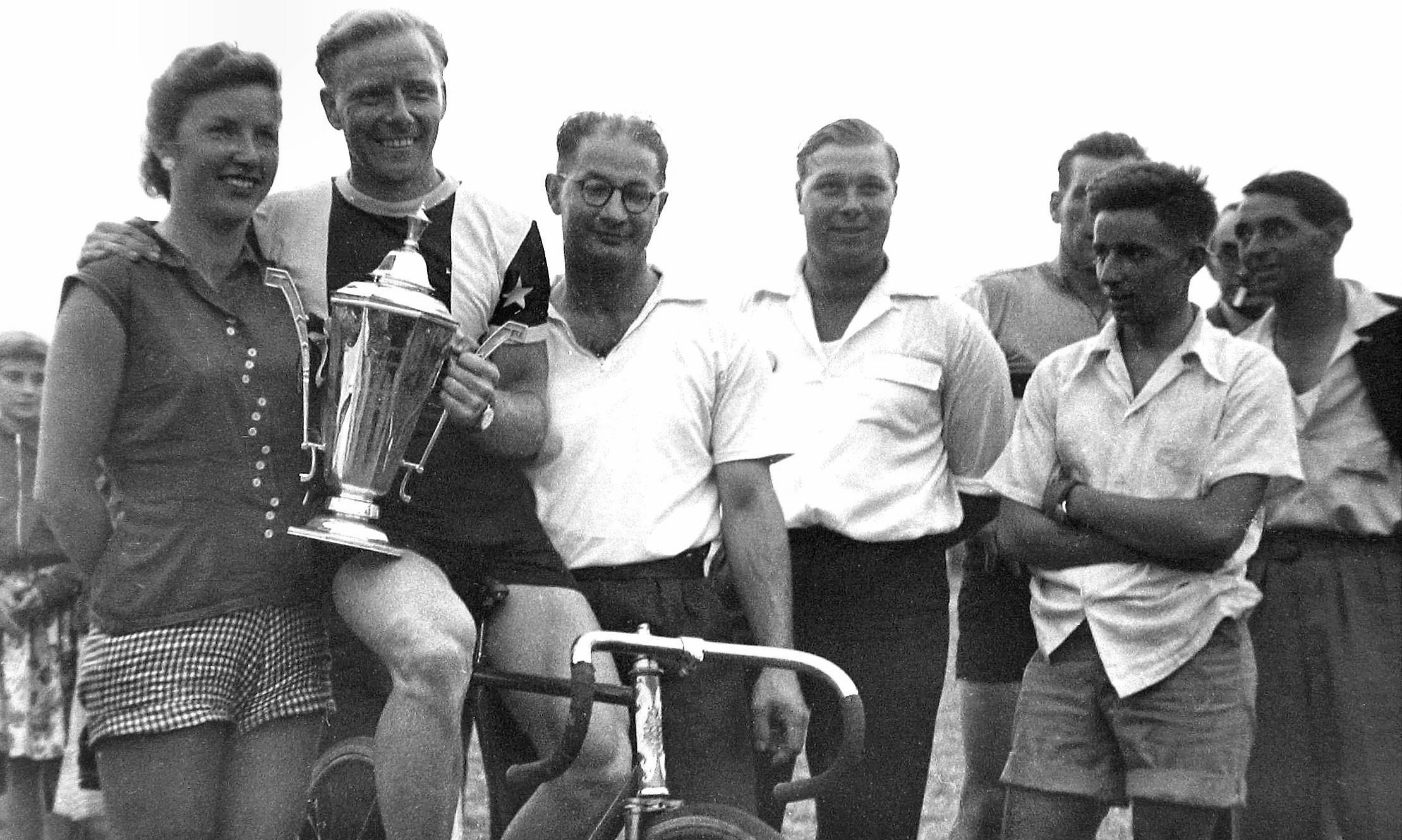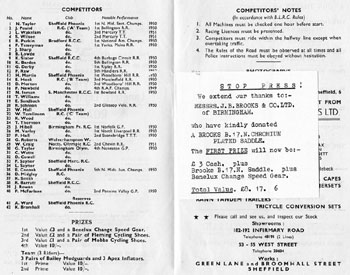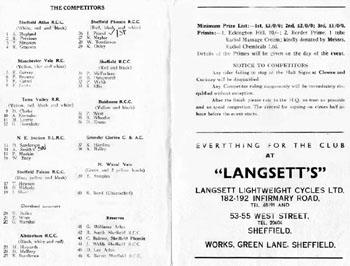BLRC - North Midlands Section 1951 - 1959
Posted: Friday 21st August 2020
Riding my first ever race, the Mansfield Victoria 25 TT on the old O1 course in North Notts. Note the blue fisherman’s jersey and football shorts. On my first proper race bike, a P T Stallard Montlhery; – fixed wheel and Dunlop 27″steel HPs. Ironic in view of my future allegiances, but at this time I knew nothing of Stallard and the BLRC; I’d just been greatly impressed when I’d ridden the same model owned by a workmate. (I recorded a short ‘9’)
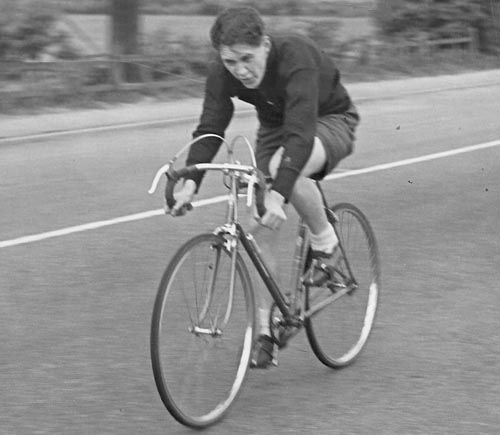
The League is the only cycle-sport event with which I am now involved, the attraction being it’s similarity with our local BLRC of 1950s when it was very much ‘by the riders, for the riders’. As was much the case then, competitors take their turn to organise, officiate and marshal. The League is also all that remains of the old North Midlands Section (BLRC) – North Midlands Division (BCF) since its elimination some years ago. As such, our Road Race League carries on a proud tradition. From its inception the North Midlands produced, for its size, more top racing cyclists than any other similar area in the UK. We had a few at our dinner including Malcolm Elliot, Chris Walker, Simeon Hempsall and Russell & Dean Downing together with a large and varied representation of the current local cycle racing fraternity. As the most ancient participant I viewed the gathering with mixed emotions. How lucky they all were compared with us with their affluence, mobility, cycling on TV, mobile phones, modern communications, etc., etc. On the other hand were not we the lucky ones(?); – to have played a part in the revolution of British cycling, to ride on virtually traffic free roads, to participate in races like the Burbage Road Race or Sheffield-Newark-Sheffield (impossible now). One thing is certain, talk to any riders these days and few have any idea what the local situation was like in the 1950s. This is my attempt to put that right with some of my own reminiscences.
North Midlands Section, British League of Racing Cyclists, 1950-59
Although I was introduced to the sport of cycle racing with a traditional leading Sheffield club the Rutland CC, once I had become aware of the scope and glamour of the Continental sport and had experienced ‘en ligne’ racing for myself, it was inevitable that I would become a keen supporter of the BLRC. Not least, because the NCU/RTTC seemed determined to stop the very sport in which I wanted to participate!
Virtually all BLRC club members were competitors. Club officials were the riders themselves, together with the relatively few ‘too old’ to compete and/or injured, plus premature retirees (from racing). Race organisation was similar. Riders would take a break from racing to officiate and help out with their own club’s promotion(s). It was expected that every club would organise at least one race every season, otherwise their chance of entries to others races being accepted were vastly reduced. There was a full programme with a race held in the Section on every weekend from March to October. Sometimes we had two races on the same weekend but at opposite ends of the Section and involving different police authorities. The date fixing meeting was often difficult with clubs arguing for their preferences.
There was no BLRC official type entry form. Clubs printed and circulated their own to selected &/or preferred clubs. Every club had a Racing Secretary who received (and sent for) entry forms and the main task was to select and coordinate club teams. You would sometimes write to request entry forms in respect of other Sections’ races. There was always difficulty getting into events , particularly for 3rd cats (lowest senior category) but a good experienced racing sec would be aware of where the best prospects were, (in my case East Mids. and Lincs.) and one would sometimes negotiate reciprocal arrangements with other clubs. This was due to the fact that the vast majority of races were restricted (by rule) to 40 starters. Most entry forms had a maximum of 6 spaces for entries and many organisers restricted clubs to teams of 3. Sometimes, with Police approval, there would be an overflow race.
There were three Senior categories; 1st, 2nd & 3rd + Juniors (16 to 18 years). Upgrading required 1 x 1st place; 2 places in first three; or 4 places in first six. Juniors, rode restricted gears, were limited to a race distance of 50 miles and could ride against 3rd cats. Any licence points would qualify them for senior upgrade. Your licence had a space for race performances and points. It had to be completed and signed by a senior race official and submitted to the Section Registrar for upgrading.
Small entry acceptance with subsequent rejections led directly to the formation of many ‘breakaway’ small clubs; or more realistically, teams. They obviously had more difficulty organising races. This in turn resulted in clubs cooperating to help one another. I believe this was another factor which contributed to the camaraderie and tremendous spirit which existed in the League. An alternative was the formation of a breakaway club where there remained some links with the original. The degree of association varied usually being determined by the attitude of their officials in respect of their NCU and RTTC affiliation. Early North Mids example was Sheffield Phoenix (Road Club) and later, Rutland (Racing Club) and Don Wheelers (Road Club). An exception to the normality of small clubs was the Sheffield Mercury RC which developed into a fairly large organisation with a ‘family’/more traditional style. (ref. note 1)
With close association and cooperation among all it’s members it was perhaps inevitable that the League became more like one big ‘North Midlands Cycle Racing Club’. For many years the Sheffield Phoenix Road club and Sheffield RCC held a joint club night every Friday. By the late 50’s when the venue was the Royal Oak (the land lord was a Phoenix member) it had become the place to be for all local Leaguers, both a social gathering and the place to sort out entries. Organisers were loath to accept individual entries and you expected to have a team accepted (3-4 riders) in every local race. Otherwise transport was involved; – usually the train.
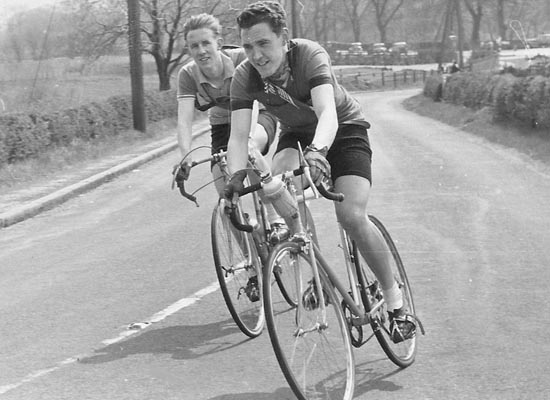
All of this highlights the big differences between then and now which affected virtually all of us. Although all had good jobs, incomes were such in those days that we all still lived at home (until married). In my club, Sheffield Racing CC, no racing member had a motor car and no one had a telephone. (ref. note 2)
Races were longer, rarely less than 50 miles (for seniors) and usually about 70/80 miles. Derbyshire was the most frequently used area. Place to place races were popular but required more organisation. (egs Sheffield-Ashbourne-Sheffield; Sheffield-Newark-Sheffield; Sheffield-Glossop-Sheffield).
Organising a race was inevitably a team effort. With no telephone, e-mails or personal transport, all communication, unless by post, was face to face (ie. club meetings or home visit via bicycle!). All races had to have a printed programme and the theory was that income from adverts would cover printing costs. So one did the rounds, (by bike) of the usual supporters; Jim Wilson, Albert Butterworth, Henry Hall, Langsett Cycles, Simpkins Vita Glucose, etc.,etc. The usual entry fee of 3/6d was supposed to cover prize list and other expenses. Standard prize list was £3, £2, £1, with a £3 team award. For anything better one had to attract more advertising or be good at begging. Another method was to try to produce your own programme (via typewriter and stencil), rarely a success. However, a £5 first and your road race became a Grand Prix! Much more and you could be considering a stage race! You always needed to call on other clubs for assistance, although the more mundane race jobs and helpers were supplied as far as possible from your own club, aided by friends and relations. These included marshals, competitors steward and, (unlike an RTTC event where he reigned supreme) the timekeeper; he was unimportant in a road race where time was of little consequence except in stage racing. Our top officials were judges and for many years we had the duo of Roy Bramall and Eric Gilbert who could always be relied upon. In the late 50’s Race Observers were introduced to actually accompany the race and they ultimately became the top man and their title changed to Commissaire.
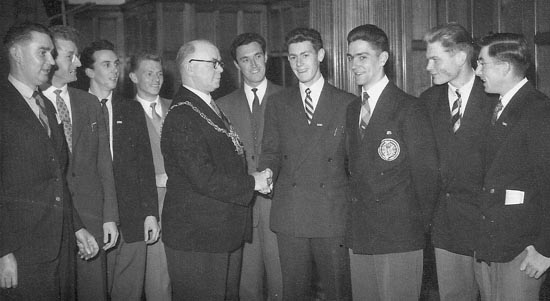
Any current bike rider would find it difficult to understand the huge contrast between the traditional RTTC/NCU affiliated and the ‘new fangled’ BLRC clubs. The whole concept was so different. First of all and to all intents, you can virtually forget the NCU bit. Track racing (hard and grass) took place in the pit villages to the East of the area and the only local ‘massed start’ races I ever remember were two events in 1948 in a (virtually) un-surfaced Norfolk Park. Time trialling (and club-runs) dominated in all the established traditional clubs. Riders strove to attain lower ‘personal bests’, essentially in 25 TTs and the basic assessment of any riders worth was his 25 mile time expressed as a numeral (ie. the number of minutes over 1 hour ). Far more rarely a ‘blob’ (60 mins) or a ‘59’, ‘58’, etc (ie under the hour). In the Rutland where I started, the great men were the ‘12’ and, even more so, ‘24’ hour riders. ‘Lofty’ Liversidge, Stuart Thompson, and later, a good friend Ron Coukham, became National 24 hour Champions and Rutland CC the Team Champions. Together with Benny Hudson (National Record holder), Ron Masterman, George Steers and Tony Foulds, they were the club heroes!
The most significant concept of British time trialling was ‘Private & Confidential’. Remote/ secret coded courses with a ‘crack of dawn’ start. No club colours, only ‘inconspicuous(?)’ black or dark clothing allowed. (Black tights & alpaca jackets had in fact ceased to be compulsory pre-war). Most important of all, no publicity. Contrast this with the BLRC where the aim was to establish continental style road racing in the UK. European racing was in essence much the same then as now in terms popularity, publicity, commercialism, etc., etc. Almost unbelievably, you would learn little of this in our cycling press. Indeed Cycling (now Cycling Weekly), if anything, positively campaigned against it! I suppose word of it came chiefly by word of mouth from those who had seen it. This included throughout the ‘40s & ‘50s many ex-servicemen (everyone had to do National Service in those days) who had served in Europe or, as in my case, elsewhere overseas.
Or, as again in my case, you had a sight of Continental sports magazines, particularly the French ‘But et Club’ and ‘Mirroir Sprint’. The sheer ‘glamour’ and epic quality of cycle racing was irresistible, particularly to young and vivid imaginations. There couldn’t have been a bigger contrast between two facets of what was supposedly the same sport. It manifested itself in many different ways: –
| RTTC | BLRC |
| Early morning start | Late morning/early afternoon |
| Start/finish, remote & secret | As close to urban area as possible |
| Racing garb, ‘inconspicuous’ | Club jersey compulsory |
| Other/ training cycling garb, ‘plain’ | Team/trade jersey (+ tub round shoulders!) |
| Fixed wheel | Derailleur gears |
| Mudguards.(removed at race start) | Never. (Except possibly in mid winter) |
| Saddlebag | Musette |
| Start sheet | Programme |
| Cycling | Bicycle |
In this area there was also a geographical divide. NCU track racing took place almost exclusively in the numerous pit villages to the East. RTTC time trial courses for the most part were held on the flat lands to the East. The majority of League clubs were based in Sheffield and the vast majority of our races were based to the West in the Derbyshire Peak District. Hence, there also developed, quite wrongly, a sort of ‘city slicker’ versus ‘country hicks’ type attitude.
However, the bottom line could be summed up by one word, – PUBLICITY. To the RTTC/NCU an anathema; to the BLRC its life blood. The RTTC whole strategy was based on secrecy. There was no desire to expand. No interest in international cycle racing (note that RTTC time trials were/are a uniquely British hybrid). Their sport existed in a withdrawn and introspective atmosphere. This was primarily due to a fear that if exposed they would be forced off the road. Abject surrender! For some there appeared to be another attraction; – the joy of belonging to an exclusive secret sect. This I believe is the basis of the ‘us & them’ attitude still prevalent in many sectors of British cycling. The BLRC policy was at the opposite end of the spectrum. Cycle road racing (en ligne) was a major sport on the continent of Europe (and further a-field). It had achieved this status on the basis of widespread publicity and continued to thrive. The League wanted the same status for the sport in the UK and obviously the only way was via publicity. Indeed, the only hope for the long term good of the sport and for UK cycling in general was its widespread knowledge and acceptance.
There was a certain irony. For the majority of racing members of traditional clubs their only form of organised competition was RTTC time trials. However, the natural instinct for road racing could not be denied. On most Tuesday and Thursday nights there were group training sessions which took the form of a chain gang. The end of any Sunday club runs would usually develop into a burn-up and a gallop for a predetermined sprint point (traffic sign, gas lamp or telegraph pole). Annual features were the numerous early season ‘reliability trials’ which inevitably developed into road races (see note 3). In fact many younger riders genuinely ‘preferred’ road racing but had a sense of loyalty and were reluctant to leave their club mates. We all know that friendship and camaraderie are very special in cycling based on that ‘brotherhood of suffering’ which I believe is unique to our sport.
After all, in what other sport is ‘the bonk’ and ‘hunger knock’ common to all participants? I write with some feeling. I had been proud to be accepted as a member of the Rutland and had inevitable made several close friendships. By sheer coincidence all started their National Service after me and were still serving after my demob. In the meantime I had become completely enthralled by road racing, but even so, I was still reluctant to leave the Rutland. (A year or two later there wouldn’t have been a problem when the offshoot Rutland Racing (League) club was formed!).
As I get older and more serene I look back and can understand the contempt that some older traditional cyclists had for we youngsters. Many were steeped into the established British ‘system’ and couldn’t contemplate anything else. Were we not a young, arrogant and disrespectful bunch of posers? Did we really believe that we were all potential ‘Tour’ riders and that the Peak District was comparable with the Alps, Pyrenees and Dolomites? That Burbage, Mam Torr and the Snake Pass prepared us for the Izoard, Galibier and Tourmalet? However, what must be appreciated and I think many subsequent and current riders do not fully appreciate is that before the BLRC road racing did not exist for the vast majority of competitors. It was time trials or nothing! (eg – In the Rutland CC hardly anyone owned a club jersey. They weren’t needed, and it was many months before I even knew what one looked like!).
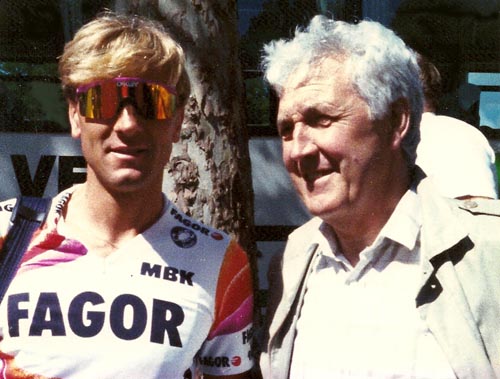
Note 1. Leading figure in the Sheffield Mercury was Bill Thompson who, on becoming National Vice Chairman, achieved the highest role in the BLRC of any local member. He was never forgiven in the Section for being a leading figure in the ultimate formation of the BCF on terms which local members considered unacceptable (I was Section Chairman at the time). The only other local National Committee Members I recall in the 50s were Nev’Taylor (who became National Registrar), Eric Gilbert and yours truly (for 1 year only!).
Note 2. Ken Slater, a Sheffield RCC team mate, bought a 2nd hand Ford Popular (without a heater) when he became fully qualified as an accountant, with the appropriate rise in salary. I remember him taking me to a few races, in particular to Mablethorpe not long after the great East Coast floods. This was the first private transport to a race I ever experienced in civy street. Whilst in the RAF in Egypt it was quite common to have motor transport provided and even air transport on a number of occasions.
Note 3. The Rutland CC had an annual early season training ride to Cleethorpes and back (approx 170 miles) which was always well attended both by members and by other clubs. It was normal club run on the way out but the return quickly developed into a full lineout, invariably becoming very competitive. In every sense it was an unofficial race with the finishing line outside the tea place at Mattersey. One of my proudest early recollections is the 1949 version and ‘breaking away’ with Ray Lockwood on the rise up to Hemswell Top and the pair of us staying away all the way to Mattersey!
Posted: Friday 21st August 2020
This article appears in the following categories.
Upcoming Events
Whether you are looking for a gentle social meet up, or a 100-mile ride browse the community’s upcoming events and plan your next weekend outing.
